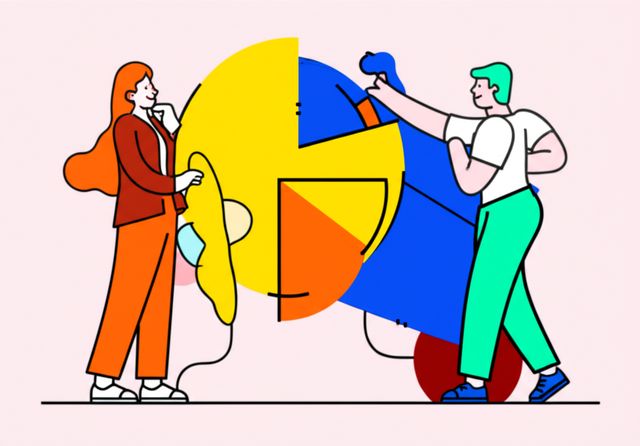Infographic Design
Infographic design is a specialized field that combines graphic design and data visualization to present complex information in a visually appealing and easy-to-understand manner. With the increasing demand for data-driven storytelling and visual communication, infographic design skills have become highly sought-after in various industries.
Understanding Infographic Design
Infographics are a powerful tool for communicating complex ideas, statistics, and data in a visually engaging way. By using visual elements such as charts, graphs, images, and icons, infographics simplify complex information and make it more accessible to a wider audience.
Infographic designers use a combination of design principles, visual storytelling, and data analysis to create visually appealing and informative infographics. They collaborate with subject matter experts to ensure the accuracy and relevance of the data presented.
Why Learn Infographic Design?
Learning infographic design offers numerous benefits for individuals seeking to develop their skills and advance their careers.
- Enhanced Communication: Infographic design skills enable you to communicate complex information effectively and engage your audience.
- Career Advancement: Infographic design is a valuable skill in various fields, including marketing, journalism, education, and data analysis.
- Increased Demand: With the growing demand for data visualization, infographic designers are in high demand across industries.
- Personal Growth: Learning infographic design fosters creativity, problem-solving abilities, and a deeper understanding of data.
Types of Infographics
Infographics come in various types, each suited for specific purposes:
- Informational Infographics: Provide factual information and explanations.
- Statistical Infographics: Present data and statistics in a visually engaging manner.
- Timeline Infographics: Depict events or processes over time.
- Comparison Infographics: Compare different options or data points.
- Geographic Infographics: Visualize data related to specific geographic regions.
Tools and Software for Infographic Design
Creating infographics requires specialized design tools and software. Some popular options include:
- Adobe Illustrator
- Canva
- Piktochart
- Infogr.am
- PowerPoint (with add-ons)
Benefits of Learning Infographic Design
Mastering infographic design can lead to tangible benefits:
- Improved Communication: Infographics make it easier to convey complex information and engage diverse audiences.
- Career Opportunities: Infographic design skills open up career paths in marketing, data analysis, journalism, and more.
- Increased Marketability: Professionals with infographic design skills stand out in the job market.
- Personal Satisfaction: Creating visually appealing and informative infographics can be a rewarding experience.
Projects for Learning Infographic Design
To enhance your infographic design skills, consider undertaking projects such as:
- Create Infographics for a Local Business: Offer your services to local businesses to design infographics that showcase their products or services.
- Visualize Data from a Research Paper: Transform findings from research papers into visually engaging infographics.
- Develop an Infographic Campaign for a Social Cause: Use infographics to raise awareness and promote social issues.
Day-to-Day Tasks of Infographic Designers
Infographic designers typically engage in the following tasks:
- Data Analysis: Reviewing and understanding complex data.
- Design and Layout: Creating visually appealing layouts and choosing appropriate visuals.
- Collaboration: Working with subject matter experts and stakeholders.
- Communication: Presenting infographics and explaining their key findings.
- Iteration and Refinement: Making revisions based on feedback and data.
Personality Traits and Interests for Infographic Designers
Individuals who excel in infographic design typically possess the following traits and interests:
- Creativity: A strong imagination and the ability to visualize concepts.
- Attention to Detail: Meticulous and thorough in their work.
- Data-Oriented: Enjoy working with data and presenting it in a clear manner.
- Communication Skills: Able to explain complex information in a simple and engaging way.
- Curiosity and Learning Agility: Eager to stay updated with design trends and new technologies.
Infographic Design in the Job Market
Infographic design skills are highly valued in the job market. Employers seek individuals who can effectively communicate data and insights through visual storytelling. Infographic designers can find job opportunities in a wide range of industries, including:
- Marketing and Advertising
- Data Analysis and Reporting
- Journalism and Publishing
- Education and Training
- Nonprofit and Government Agencies
Online Courses for Learning Infographic Design
Online courses provide a convenient and accessible way to learn infographic design. These courses offer a structured learning path, expert instruction, and the opportunity to develop practical skills through hands-on projects.
Online courses cover various aspects of infographic design, including:
- Design Principles: The fundamentals of infographic design, such as color theory and typography.
- Data Visualization: Techniques for presenting data in a visually appealing and informative manner.
- Software Training: Instruction on industry-standard infographic design software.
- Case Studies: Examples of successful infographics and their impact.
- Project-Based Learning: Opportunities to create and refine your own infographics.
By completing online courses, learners can gain a solid foundation in infographic design and develop the skills necessary to create impactful and engaging infographics.
Conclusion
Infographic design has become an essential skill in today's data-driven world. With its ability to simplify complex information, engage audiences, and drive communication, infographic design offers numerous benefits to individuals seeking to advance their careers or enhance their personal knowledge. Online courses provide a convenient and accessible way to learn infographic design, equipping learners with the skills and knowledge necessary to succeed in this field.


